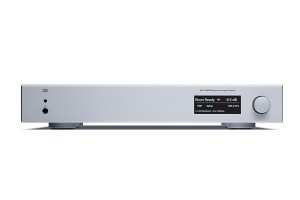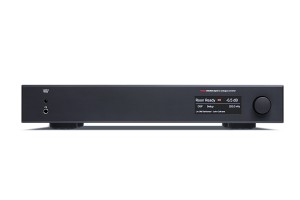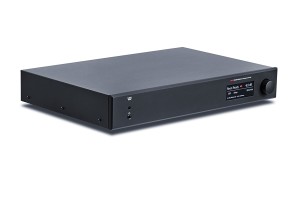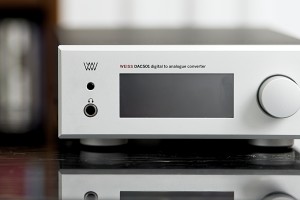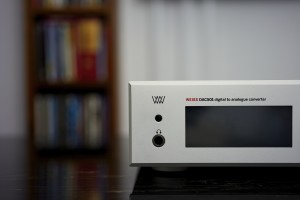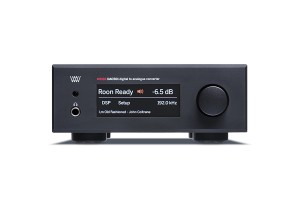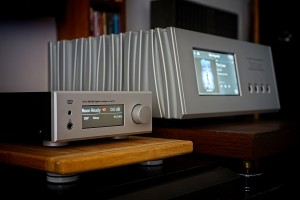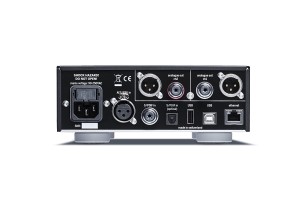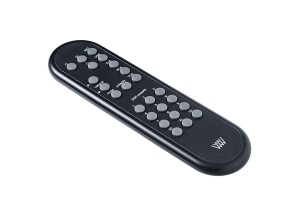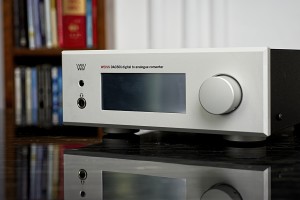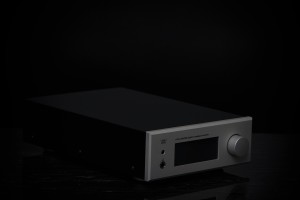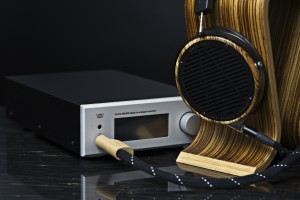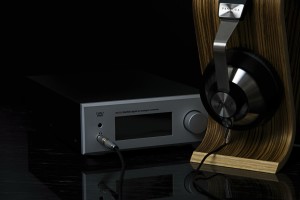A small body D/A Converter packed with features including an advanced DSP from a renown Swiss pro and hi-fi manufacturer promising a truly high-end sound. Interested? Excited? Me too! Let’s confront the premise with performance actually delivered by the Weiss DAC501.
Introduction
While Weiss is a huge name in pro-audio world and I am pretty sure most audiophiles at least recognize it as well, I don’t know that many users of these products among music lovers. Obviously they don’t come cheap, which limits the number of potential owners, but I guess many audiophiles think of Weiss as a pro-audio brand. And you know as well as I do that many music lovers consider these, for whatever reason, at least the „other side” or even „an enemy”. I have to admit that even I, a man in some way engaged in the audio world for almost 20 years, haven’t had a chance to listen to any product of this Swiss brand in my own system before. It actually was a friend of mine, Mr. Marc Loubeau of the Prestige Audio Diffusion, who suggested I should listen to the new DAC501 or 502 by Weiss Engineering and put me in touch with Daniel Weiss.
That’s the man himself presenting his new “babies”
So just to „soften” hardened audiophiles a little before getting to the subject of this review, how about we dig a little to the history of Daniel and his company. Let me use information readily available:
„Daniel graduated in 1979 with a BSEE from the HTL Rapperswil. Joined the Studer Revox company in 1979 as an Electronics Engineer. There he worked on analog anti-aliasing filters, test signal generators, sampling frequency converters and digital audio processing for a two channel DASH recorder. He left Studer in 1984 to start (in 1985) the Weiss Engineering Ltd. From the outset the company concentrated on the design and manufacture of digital audio equipment for Mastering Studios. A Mastering Studio is the place where a recording gets its final touches for optimum artistic, musical and sonic quality.
The modular 102 Series system was the first product line and was sold worldwide via the Harmonia Mundi Acustica Company in Germany. Even today this system is still up to date (24 Bit/96 kHz). One of the largest setups of a 102 Series system was used at Sony Music in New York in the form of the IBIS digital mixing console. Sony used it to mix classical music recordings.
In the early nineties the Weiss Gambit Series was launched. It consists of stand-alone units like Equalizer, Dynamics Processor, De-Noiser/De-Clicker, A/D converter, D/A converter, Sampling Frequency Converter etc.. The Gambit Series took ergonomics and sonic quality to a new level. 40 bit floating point processors and sampling rates of up to 96 kHz are employed. Weiss Engineering is recognized as the leading company when it comes to signal processing for Mastering. Quite likely many of the CDs in your collection have been mastered using Weiss equipment.
Starting in the year 2000 we entered the High-End Hi-Fi market with a new product line. With our expertise in the design of top quality audio equipment for the most discerning clientele, the Mastering Engineers, it seemed like a logical step to design equipment for the demanding audiophile.
The point of presenting a short version of the Weiss Engineering story, as well as using the Q&A with Daniel (see HERE if you haven’t read it yet) as a prelude to this review is to remind you that these two worlds of pro and consumer audio are connected, intertwined even, and the Weiss Engineering is a good example of a company that is able to greatly contribute to both of these worlds.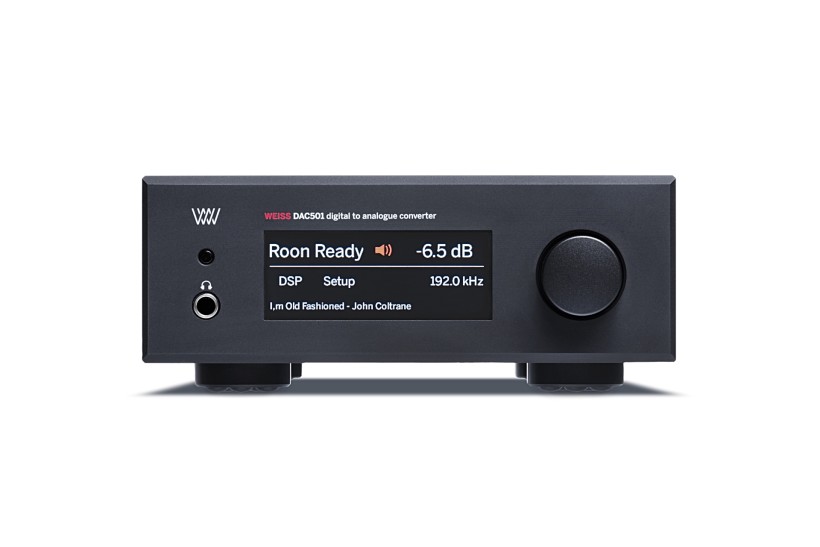
Features
For the purpose of this particular review Daniels was kind enough to send me one of the two latest additions to the Weiss home audio lineup – DAC501. The other one is called DAC502 and despite the fact it features a different, much bigger (standard size) chassis the only other difference is a 4-pin XLR headphone output placed on the rear panel. The DAC501 does almost everything one expects a modern DAC to, supporting both PCM (up to 384 kHz) and DSD (64 and 128) formats. There is no MQA support but… well I’ll leave it up to you whether this is actually a problem. It’s not a real one for me but you should know about it. On the digital input „front”, so to speak, it is also quite versatile offering user a wide choice including: AES/EBU, SPDIF RCA and well as Optical Toslink, Audio USB and Ethernet port (UPnP/DLNA compatible). The device is also „Roon ready” (which may solve the MQA problem for those who can’t live without it), so any computer or streamer with Roon will „see” DAC501 as an endpoint if both devices are connected to the same local network.
As for the outputs one can use either balanced (XLR) or unbalanced (RCA) analogue ones as well as a 1/4 inch headphone output (on the front). There is a volume control too, should one wish to drive a power amplifier directly with DAC501. One can operate this converter in one of three ways – manually via a touch screen and rotary encoder knob, via web interface from e.g. a laptop, or using a handy remote control. A solid, robust chassis is made of steel sheets completed with a 10mm thick aluminum fascia. I took a peak under the hood but most elements are well-shielded hence not so easily accessible, so I didn’t see much. One things is sure though – the internal design is very neat, well thought-through. Since I couldn’t really see much details I’m going to trust information provided by the manufacturer in this regard. As it reads in company materials DAC501 features the latest 32 bit D/A Converter chips (ESS Sabre) in two D/A conversion channels per audio channel configuration.
To further enhance the performance an internal high precision/low jitter clock generator was used to clock the D/A converter section. The sampling frequency of that generator is fixed at about 195 kHz. The input signals are converted to the 195 kHz sampling frequency for optimal signal quality. This scheme also helps significantly in reducing any jitter related effects. All standard sampling frequencies up to 384 kHz plus DSD64 and 128 are supported. To enhance all the electronic circuits performance manufacturer decided to use a powerful non-switching power supply featuring two toroidal transformers. All sensitive voltages sport their own regulators which are separated between left and right channels. The power switch activates a semiconductor relay which only switches on or off at zero crossings of the mains voltage. This assures a glitch free power switching. Mains voltage selection is done automatically by measuring the mains voltage before power is applied to the rest of the electronics.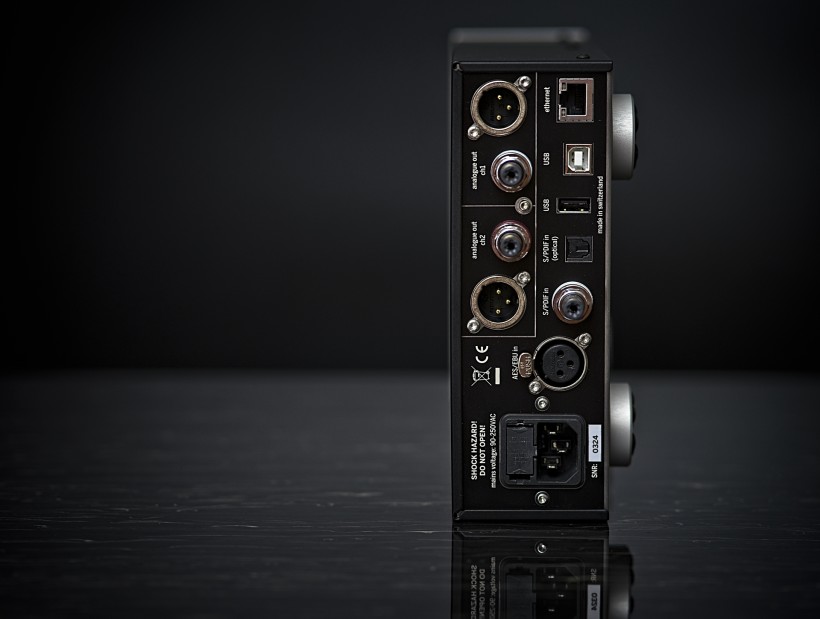
Now, what really sets this device apart is an implemented signal processing executed by a build-in DSP and proprietary algorithms developed by the Weiss team. Again I am going to use the information provided by Weiss regarding DSP algorithms currently implemented or to be implemented soon:
Room Equalizer – to suppress room modes for a decent bass reproduction.
Creative Equalizer – a tone control with low boost/cut, high boost/cut and mid boost/cut. Very useful to correct those recordings which do not sound quite right.
De-Essing – the automatic removal of overly bright sibilances from human voices. The sibilance effect can be more or less pronounced depending on your speakers or room acoustics.
Constant Volume – adjusts the audio volume (loudness) to a constant value across all tracks played. Useful for “party mode” when the volume control should stay untouched.
Vinyl Emulation – get that special sonic character of a record player based playback chain. We also employ an emulation of the DMM-CD procedure offered by the Stockfisch label.
Crosstalk Cancelling (XTC) – for the playback of dummy head recordings or live recordings via speakers for an incredible live sensation. Dummy head recordings usually are listened to via headphones because they only work properly if the left channel goes to the left ear only and the right channel to the right ear only. With speakers this is difficult to achieve as the left channel goes to the left and the right ear. But with some clever signal processing of the speaker channels it is possible to suppress the crosstalk, i.e. the audio going from the left speaker to the right ear and vice versa. If that works properly then the recording sounds as if one would be in the space where the recording has taken place. All the reverberation and 3D representation of the sound sources is there.(For speaker based playback only.)
Loudness Control – a listening volume dependent equalization of the audio.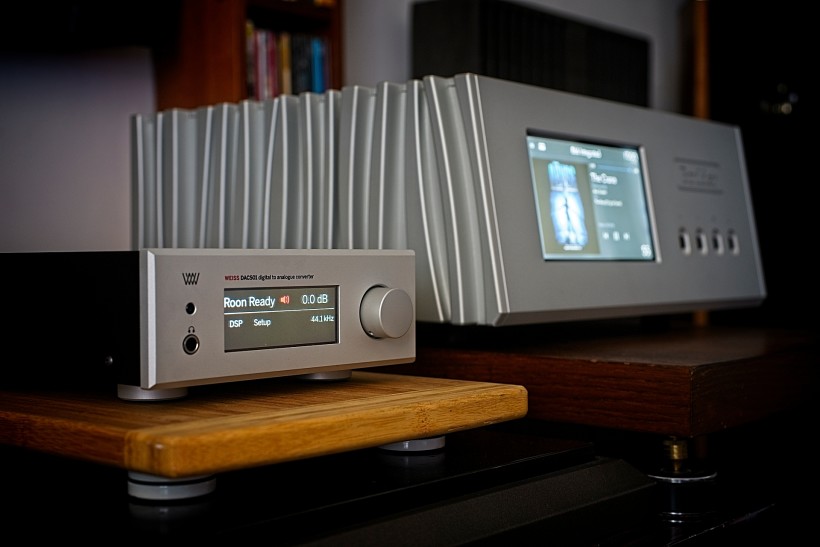
A leaflet I got with the reviewed unit states that there are still quite a few more DSP features in development and they will be provided to users with future firmware updates. For speaker playback these will be, for example: mid/side control for stereo stage widening or reverberation to liven up dry recordings. Headphone users might also find these two useful but there is another one being developed, namely an equalization for headphone/hearing combination frequency response correction. So the DAC501/502 are not a finished project, their development will continue. As you can see the DAC501 offers users tons of options of improving or tuning the sound to make the presentation even more satisfying. Something most competitors don’t provide. You will find some more features that reach beyond standard followed by most customer audio products, like, for example, an output level and polarity adjustment, or a balance between channels. There are also more popular ones such as an option to dim or even turn off the display or mute the output. If you’re a headphone person you should benefit from the aforementioned 6,3 mm jack headphone output on the front.
The output level adjustment, I’ve mentioned, is separate one from volume control – one can choose between: 0, -10, -20 or -30 dB for the output. Interestingly, when used to drive power amplifiers directly, the „0 dB” setting combined with the lowest volume level setting did not result in a silence in the speakers. It’s just for you to know – when listening in a very quiet environment in the late evening I had to set the output level to even -20 dB. Also the four anti-vibration feet the whole device sits on are quite different, as the bottom of each of them actually contains five separate… not really balls, but something like that with a flattened top. The make and finish are simply very good, there is nothing to complain about.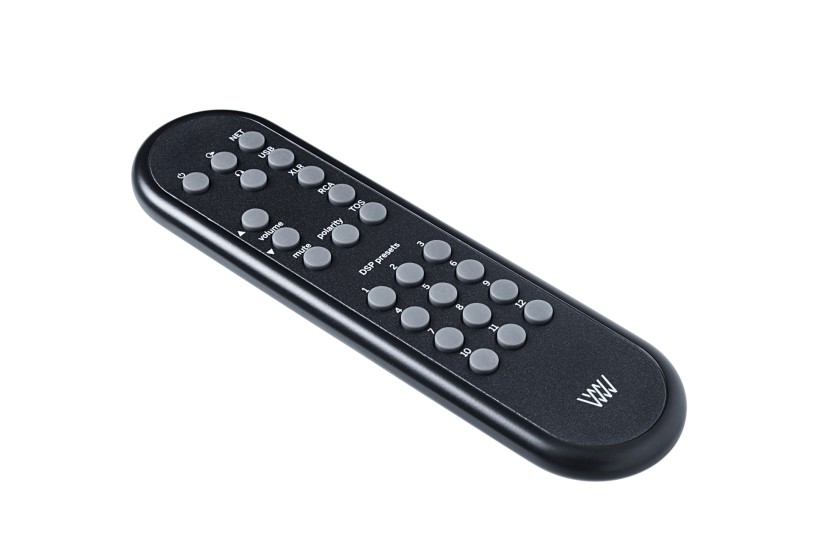
Sound
The DAC501 came well-packed and the inner box is even quite elegant but at the same time providing necessary protection for the device. To be honest I was a bit surprised with the size of the device – looking at the photos doesn’t really give you a sense of scale and at the same time the long list of features and options somehow created in my mind a picture of a „bigger” device. As it later turned out it does have a big heart, but as for its dimensions it’s actually quite small so it will easily fit in any environment, also on the desk. For simple operations you will probably use mainly remote control, but when it comes to the DSP, the web-based interface is the way to go (at least it was for me). Depending on the amplifier I combined the Weiss with, I used either balanced or unbalanced analogue outputs. As for digital inputs I used mostly USB and LAN ones to play files from Roon installed on my Audio-PC or from Soundgenic music server and transport.
The USB driver for Windows, available on the Weiss website, installed and worked without any issues. Also as soon as I connected the DAC to LAN, Roon on my PC recognized it as readily available endpoint I could play music to. At some point of the extended review period a new firmware for DAC501 was made available – again installation went smoothly, no issues whatsoever. So basically owner of the DAC501 deals with a fuzz-free device – easy to setup up and to use. That’s something that could be attributed to the pro-audio heritage – devices used in studios must operate smoothly and do their job, period. To fully benefit from DSP options some reading is required but once you study the manual you should be able to use it without an engineering degree.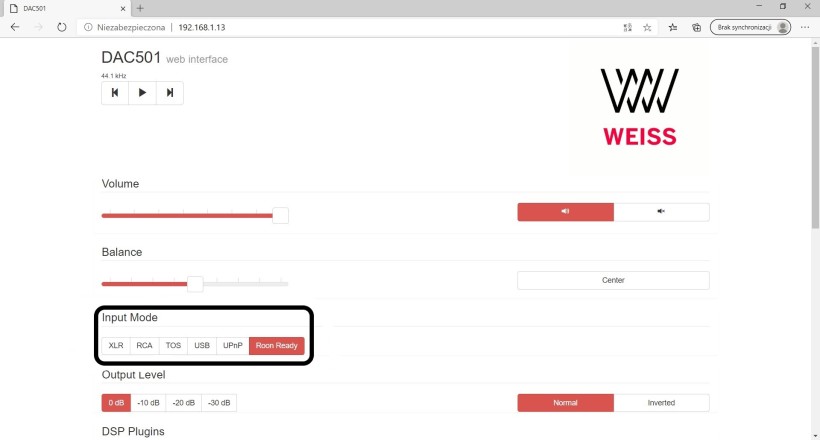
So, let’s finally get to the most interesting part – how does the Weiss DAC501 perform? I decided to initially use the DAC501 simply as a D/A converter and deal with DSP options and headphone output later. I actually ended up using it also as a preamplifier/DAC combo driving the LampizatOr hybrid Metamorphosis monoblocks and this setup turned out to be quite impressive so if you’re looking for a minimalistic system – say with a computer as a source, DAC/digital preamp in one driving power amplifier/s – this little Weiss may be what you’re looking for. But first thing first.
Over the years I’ve learned that more often than not source components developed by companies with pro-audio background tend to excel in terms of transparency, clarity, delivering an abundance of details, or low-level resolution. They usually offer quite open, coherent and well-balanced sound. And the ultimate goal usually seems to be to offer as neutral presentation as possible. If you have already read my interview with Daniel Weiss (if you haven’t you definitely should! :)) you would know that it is also his and his team’s goal – a neutral performance of all their components. I am willing to bet that given the chance most of you will quickly recognize all of the above listed sonic features in the DAC501’s performance. All delivered in spades. We are talking about a truly high-end level sound.
Over several days I listened to countless recordings, both in PCM and DSD formats, regular and hi-res ones, via USB and LAN inputs and the conclusion was the same each and every time. What I heard from the speakers depended almost exclusively on the quality of particular recording (and release), much less on the format or resolution of the played files. Sure, my personal taste didn’t suddenly change and I still slightly preferred DSD recordings over PCM as sounding richer, smoother, more natural, but as for the latter anything from 24/48 kHz up sounded almost identically good for me. The performance was amazingly consistent in terms of lack of coloration, it was also very resolving, dynamic, effortless and open. Having said that, I have to point out that the DAC501’s ability to differentiate tracks’ quality and character was, simply put, remarkable. So the above mentioned „consistency” had nothing to do with making all recordings sound the same, or equally good as many mediocre audio components tend to do. Long story short – my expectations (one could call them prejudice :)) were in this regard perfectly met – that’s how a D/A Converter from a renown manufacturer with its roots in pro-audio should have sounded like.
There was one thing though, that kept bugging me. Why exactly did I like it so much? The time I spent with DAC501 wasn’t just about reviewing or assessing it. I also used it to listen to the music „after work” and enjoyed my time with it a lot! And, to be perfectly honest, I am no fan of typical „pro-audio” sound. While I appreciate the whole list of the sonic features listed above, for me they are simply not enough to fully enjoy the music. I often find this type of devices ultimately sounding rather dry, lacking in terms of richness, saturation, tonality and, maybe most of all, expressiveness.
They may sound „neutral”, according to many, but not particularly natural from my perspective (as I expect the sound to be as similar to the one I know from live performances, especially of acoustic sets, as possible) and they often (with some exceptions) fail to truly engage me, to provide me with immersive musical experience. And that’s a must for me. With the Weiss DAC501, as I realized as soon as I started to wonder why I liked it so much, the performance is best described as neutral and natural at the same time. That’s how live music is, that’s what makes it so special, so captivating. And that is why the DAC501’s performance, bit unexpectedly, was as compelling to my music lover’s side as it was to reviewer’s.
Everything about the music coming from my speakers was simply right. The presentation was remarkably rich with details, textures and subtleties but still, these were just an element enriching the bigger picture, allowing me to experience music in a better way. Even though it’s a solid-state device, unlike my LampizatOr, it does offer delightfully spacious sound. It easily reproduces the feel of large space, precisely places phantom images within the soundstage and gives each instrument and vocal a three-dimensional, palpable body and space to breath. There is not even a hint of any nervousness or strain in the sound – the DAC501 delivers a relaxed and yet lively, vivid, dynamic and powerful (whenever required) presentation.
I could only applaud its PRAT performance particularly when listening to numerous blues and rock albums. And by the way – the Weiss DAC501 is a „living” proof that a device with a pro origin is capable of playing lesser quality recordings, say most of the rock genre, in a way that is highly enjoyable. That means, without emphasizing flaws such as brightness, harshness of treble or less-than-perfect clarity of midrange, or compression generously used by sound engineers. And while such flaws are there, you can hear them they do not suck the fun out of such music, they do not annoy. The bass and lower midrange, that are key parts of the band for rock and electric blues recordings, are very well controlled and differentiated, rich with low level details. Bass is nicely extended, fast, taut and when needed it slams you real good. The midrange is richer and more colorful than I expected (the tube based LampizatOr DAC sets the standard for me in this regard, so it’s not easy for any solid-state device to meet it). Treble is vibrant, open, delivered with sparks when needed, and yet smooth. All these elements are combined skillfully into a very coherent and, let me repeat again, natural performance. Long story short – Weiss DAC501 as a DAC is an excellent performer. I couldn’t really decide whether I preferred the USB input or LAN – both delivered equally remarkable performance.
Next, I challenged the headphone output of the Weiss DAC501 using my two favorite cans – Audeze LCD3 and Final Sonorus VI. I am not that much of a headphone freak and I use them only occasionally but I assumed that many potential users would wonder whether Weiss would be able to drive whatever cans they use or a separate headphone amp is a must. Top tier Audeze are a good way to verify that. From my experience these are remarkable headphones but you need a damn good and powerful amp for them to fully spread their wings. In most cases of, lets call them, integrated headphone outputs/amplifiers, featured in DACs, preamplifiers or integrated amplifiers, all you can count on is a half-decent to decent performance, that is quite far off from the LCD3’s full potential. Long story short – the Weiss headphone output did a better than average job with these cans.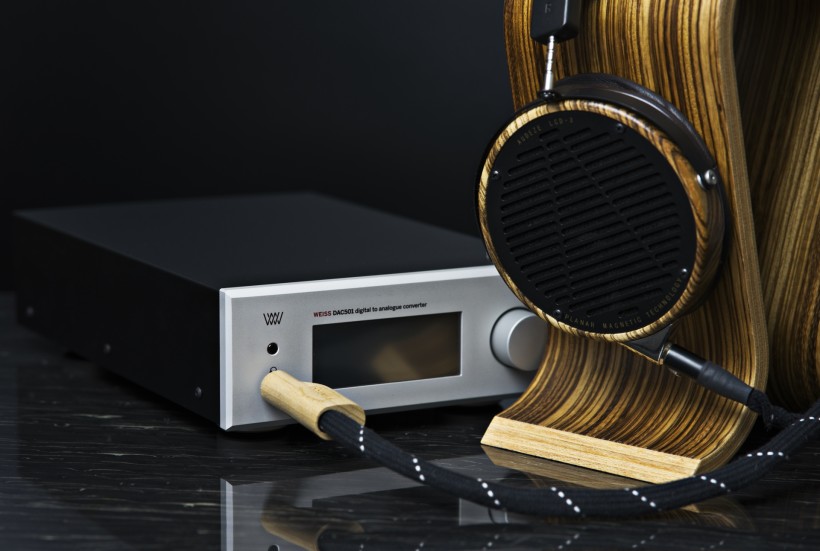
The sound was quite resolving, a bit on a warmer and darker side (that’s what a potent outputs of the best headphone amplifiers are for, as with them these cans turn into much more lively, dynamic beasts), smooth, with a touch of emphasis in the lower midrange, deep, fast enough bass and crisp treble. It was also quite spacial and revealing without becoming analytical. These cans can still do much better but it takes a stand-alone headphone amplifier that costs, say, half of the DAC501’s price. Having said that, I have to add that overall the performance was enjoyable and usable, meaning that owning this device and lacking a good separate headphone amplifier I would still enjoy listening to the music with it whenever using loudspeakers wouldn’t be possible (late night, for example). Especially after I discovered for the first time (that tells you how rarely I use cans these days) the Audeze presents in Roon. These made things even better, but I digress.
This experience encouraged me to try the combination with Final Sonorus VI cans (actually I got mine when the name was still Pandora Hope VI). These cost significantly less (LCD3 is more than twice as expensive) but offer exceptional price/performance ratio and are much easier to drive. Not to overextend this already long review, let me put it this way – having Weiss DAC501 and these cans I wouldn’t be really looking for a separate amp to drive them. This is a damn good combo. All the features of the DAC and headphone output and these headphones combined mount up to a wonderfully resolving, coherent, musical, dynamic and immersive musical experience. It would be really hard to top without an amplifier that would set me back a significant amount of money.
So yeah, unless you’re a true headphone aficionado who spends a lot of time with cans over your ears, my guess is you’d be happy with this setup. I don’t like to quantify such assessment, but if I had to I would say that with Weiss Sonorus VI present some 90, maybe even 95% of their full potential. If you want to push for the other 5-10% even if it means spending another, say, 2k EUR for an amp, be my guest. I wouldn’t do it. To summarize this part – as a headphone amplifier DAC501 is a surprisingly capable performer, just don’t expect it to drive the best cans in a way that expensive separate headphone amplifiers do. Yet, with many headphones you can expect a better performance than most integrated outputs/amplifiers do and with those not very expensive ones Weiss may be all you need.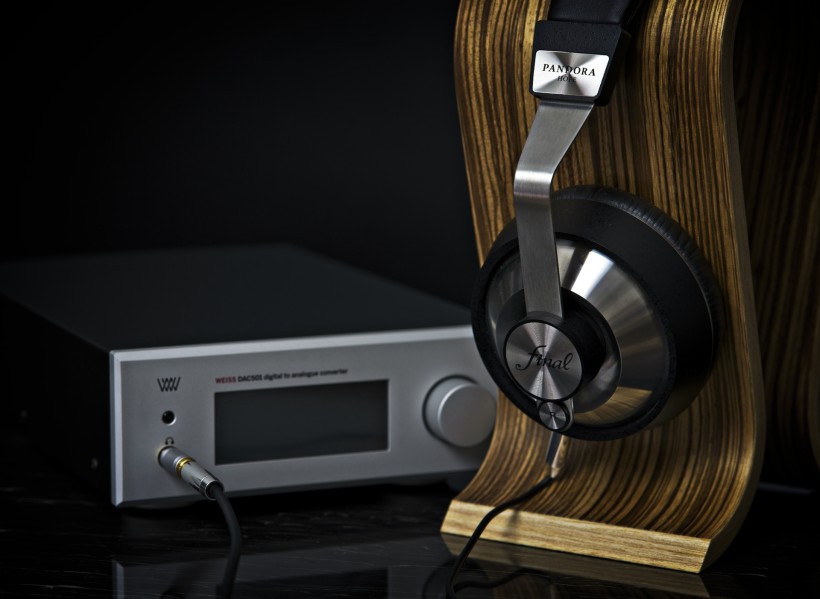
When we exchanged emails with Daniel it was obvious to me that he was particularly proud of the DSP algorithms implemented in this device. So I simply had to learn myself what was all this fuss about. I started with… those who know me surely guessed right – vinyl emulation. It’s no secret that the vinyl record is my preferred music medium (I like reel-to-reel tape even better but I don’t have a reel-to-reel recorder so it’s a platonic love). An engineer at Weiss spent a lot of time figuring out what is it about vinyl records that (some) people so rave about and how to create an algorithm that imitates such sound (and implement it in DAC501 obviously). Operating it via web interface from my laptop was the most convenient way to check it’s performance out.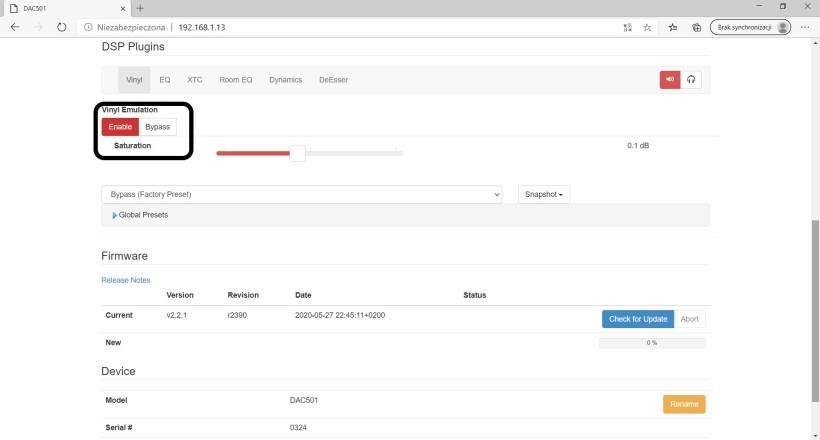
In practice what you get with Vinyl emulator is two buttons and a slider. You can either turn the emulation on or bypass it (buttons) and to adjust a level/saturation of the emulation. If you move the slider to the far left the sound gets louder and, I would say sharper, clearer (I mean in the way that a photo gets sharper and clearer with more precise focus). You move it to the right and it gets richer, particularly in the midrange area, more palpable, more present, but gradually looses part of its clarity and sharpness – maybe crispness would be a better term here. The scale for the slider starts with -9 dB on the left and goes up to +20 dB on the far right. To my ear the +1 dB setting seemed to result in an optimal balance between richness/softness and clarity and the final result seemed most natural.
The further to the right I moved the slider the more „muddy” the sound got and close to this end of the scale it got distorted (and significantly quieter too). It is an oversimplification but one could say that pushing the slider left results in a clearer, crisper more „digital” sound, while pushing it right makes it warmer, quieter, (to a certain point) more present and less transparent (more analogue?). Does it makes digital files sound quite like a vinyl record? No, it does not. Though it does change the sonic signature of the former towards that of the latter, but it’s not the same and probably it can’t really be. Still, it can be a useful tool if: a) you’re in the mood for a softer, more present, warmer presentation; b) you’re listening to lesser quality recordings that are bit too bright, harsh, edgy or grainy, particularly in the top end, or flat, lacking richness in the midrange – the vinyl emulation can make listening experience more pleasant in such cases. To be honest I ended up with this feature bypassed completely for most of the time, although I did use it for some poorer quality albums. But I think that in some systems, particularly ones that in general sound bit too bright/harsh it can be a very useful tool, especially because one can play around with this setting to find an optimal one for particular situation.
The next one on the list is the Multi-band parametric equalizer. I’m old enough to remember the times when equalizers were part of many systems. Today they are not so popular, especially among audiophiles, but can be useful in some situations. The „multi-band” in the name actually means three bands. One can choose independently for each of them a particular frequency and one or two (depending on the type) other parameters that shall be applied to it – namely gain and Q. There are five (or six if we count the bypass option) types of the equalization – low shelf and high shelf (so the equalization is applied below or above set frequency), low and high cut (everything below or above set frequency is cut off) and peak. You can play around with these settings, for example, if your system needs a boost at certain frequency range. Or you can bypass it completely – it’s up to you, but you have an additional tool at your disposal.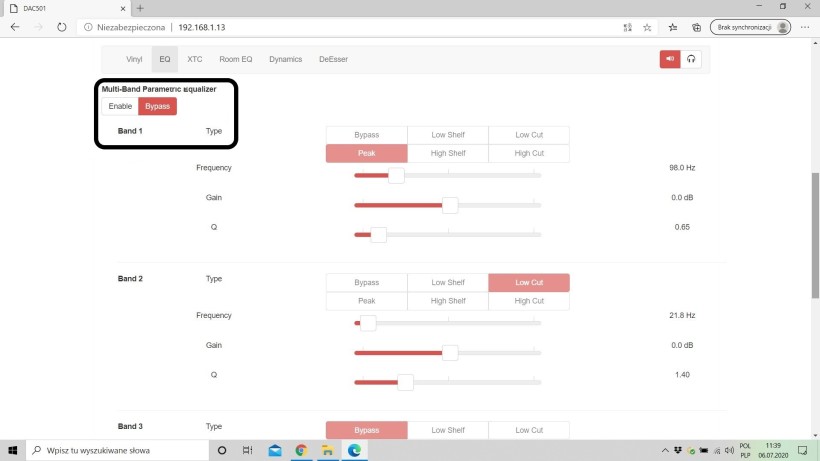
The next one called XTC or the Crosstalk cancellation will be particularly interesting for those who listen to music with speakers placed relatively closed to each other. The whole point is to make a listening experience somewhat similar to that offered by headphones, where crosstalk between channels is close to zero. When it comes to loudspeakers the point is to limit the sounds from a right speaker crossing to the left ear and the from the left speaker to the right ear. Using sliders one sets the distance between speakers and actually the maximum one that can be set is 2 meters – if yours are placed much wider apart you probably won’t benefit from it. Than one sets a distance between listener and the line between speakers. When the ratio between these two distance is not optimal the algorithm will let you know and turn the background of these two sliders yellow. Manufacturer says that while the algorithm won’t work optimally in such cases you can still try it yourself whether it does any good for your system.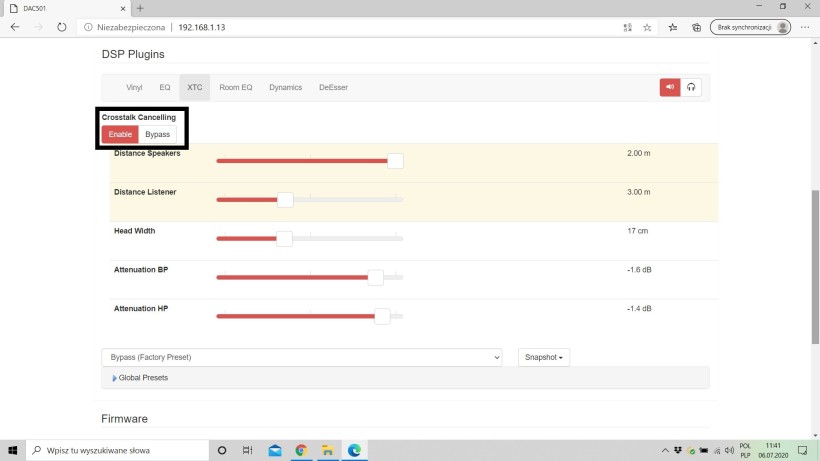
There are three more sliders – one allows you to set the width of listeners head (although this parameter is not critical), second one sets the BP attenuation and the third HP one. The former controls midrange, the latter high frequencies. It’s your job to find optimal settings. I didn’t really benefit from this one as the distance between the speakers is greater in my room than 2 m and when both distances were set (the first one for the maximum value of 2m) the background did turn yellow. No doubts that when I played with these settings the changes to the soundstage, mostly its depth, were quite significant so in some cases it will be another useful tool to optimize listening experience. But it is designed mostly for those who are forced to place their speakers close to each other. In such case, I imagine, it can do a lot of good.
I’ll skip the Room EQ for now and move to Dynamics Adaptation. What it does comes down to reducing dynamic range for all played tracks (when enabled) to a set level. The dynamic range of different albums, sometimes even track can vary quite significantly so one track might be much louder than the next one. Turn on Dynamics adaptation, set a level and all tracks will be played at more or less the same level. A simple tool that may be useful if, for example, you want to play music in the background.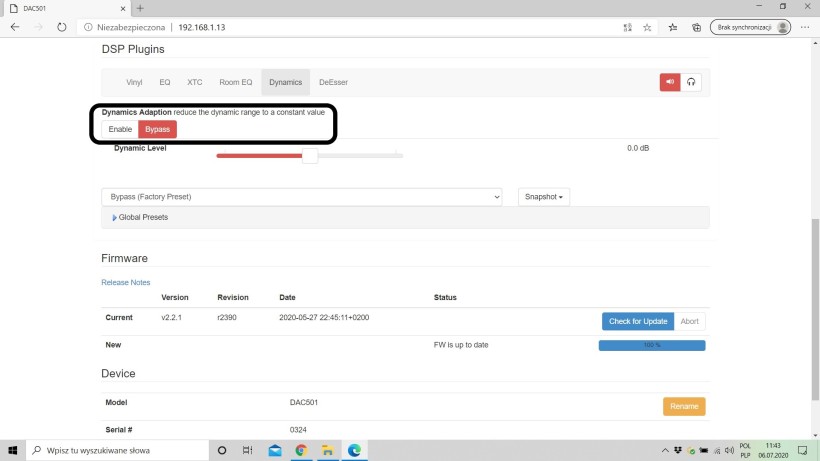
The next one is self-explanatory. It is called De-Essing. With this algorithm on, the DAC501 will smooth out any sharp elements, i.e. sibilances that are often present in vocals. There are two modes: surgical and smooth ones and a slider that allows you to set a level of de-essing. Again the names are sort of self-explanatory – surgical should be used to selectively remove sibilance, the smooth one results in an overall mallow sound. The latter may come handy when listening to a bright recordings to make them more pleasant to listen to. And it works. It seems that if your system is a nicely balanced one and you listen to mostly decent recordings the „surgical” de-essing is preferred for the recordings that need it. The Weiss DAC501 manual is very informative and includes a lot of information on this particular issue as well.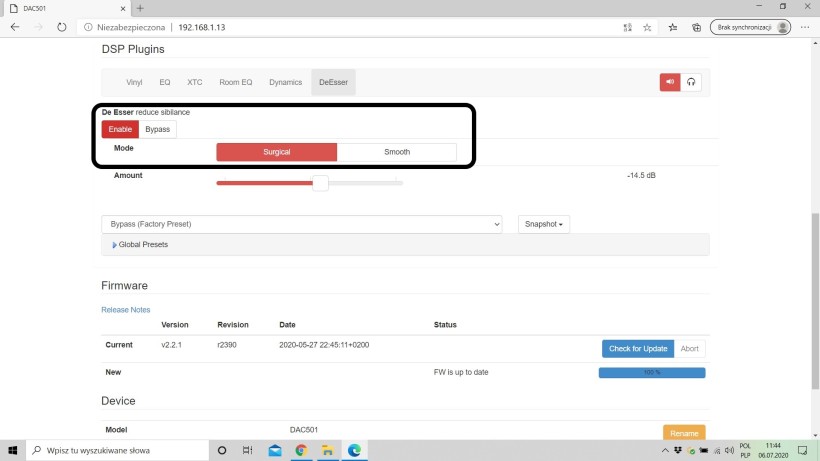
Last but not least, the Room EQ. As the name suggests you can use it to solve some issues with your room’s acoustics. To do that first you need to identify these issues, or the so-called room modes. Again the manual will lead you through the process. To perform the equalization without proper measurements (which is always a preferred method but usually not available to many, if not most, users) you need to download a flac or wav file from Weiss website. It contains a sine wave. You need to play it through your system while sitting in your regular listening position with… pen and paper in your hand. Your job is to notice and note time stamps within the track when its loudness peaks. Than you need to check these particular time stamps against the table included in the manual and „translate” them to certain frequencies – these are your modes. Only then you need to start the Room EQ function and go band by band to input the modes frequencies and follow the instructions from manual.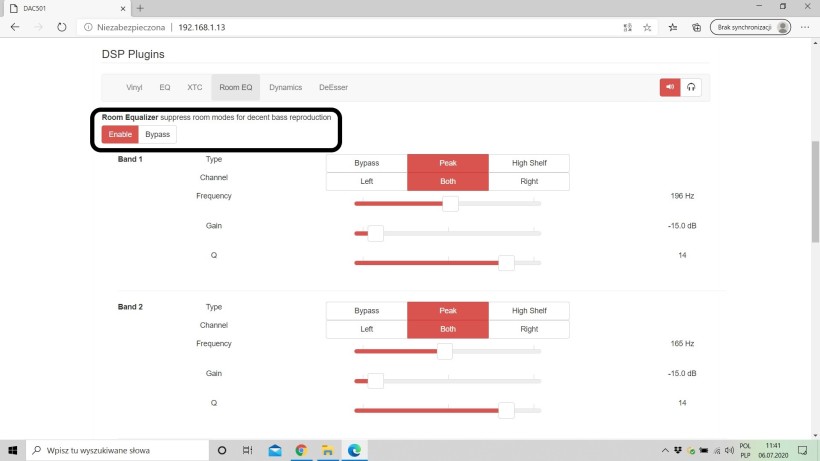
For each frequency you need to choose two settings and the manufacturer suggests starting points for both: -15 dB for gain and 14 dB for Q. Do that for all noted frequencies (assuming there are no more than 5) and play the file again. The loudness peaks should be more or less gone. If they are not you can adjust the settings. Just repeat the procedure until you find an optimal set of equalizations. It will probably take some time but it’s worth it. At least you’ll start to appreciate changes after a while, because the introduced changes will probably push you out of your comfort zone, i.e. the sound you got used to. The change most definitely will be for the better (once you’ve found optimal settings, that is) but you may need a while to fully realize that and adjust to it. In my room eliminating (or minimizing) the identified modes resulted in an impression of a less-bass-rich sound.
But what actually happened was that the „boomy” effect was canceled (one I didn’t even fully realize existed), bass got less bloated and much cleaner, tighter, better defined. It seemingly carried a bit less weight, a result of less interaction with the room, I imagine, but became better differentiated. It took me a while to get used to the „new sound” but when later I turned the equalization off I finally truly appreciated what the DSP in DAC501 did for the performance of my system and I liked the sound without it much, much less!
One last thing – you can save sets of your settings for each algorithm as presets and later recall them using numeric buttons on the remote. So you can build one preset for, say, rock music, another for live concerts, classics, night listening, and so on. Clever and convenient!
And that’s the bigger brother, the DAC502
Summary
I hope it is clear by now how good, in my opinion, the Weiss DAC501 is. Adding this device to your system will likely significantly improve its performance. Either because it will be a better, more resolving, open, spacious, precise and yet natural sounding source than the previously owned one or due to the DSP that will help you fix specific issues or enhance listening experience. Either way, I don’t see how you could go wrong choosing the DAC501. Especially that it is also more than decent headphone amplifier and digital preamplifier, which could save you quite some money as you won’t have to purchase separate components. If you have a chance give it a try! I am adding the Weiss DAC501 to my list of highly recommended components and I definitely wouldn’t mind using one in my system.
Price (when reviewed):
- Weiss DAC501: 8.000 CHF (excl. VAT and shipping)
- Weiss DAC502: 9000 CHF (excl. VAT and shipping)
Manufacturer: WEISS ENGINEERING ; LIVEBOX
Specifications (according to the manufacturer):
- Digital Inputs: (1) XLR, (1) RCA, (1) TOSLINK (optical), (1) USB type B, (1) RJ45
- All inputs accept professional or consumer standard , i.e. accept AES/EBU or S/PDIF signals. Sampling frequencies: 44.1 kHz, 48 kHz, 88.2 kHz, 96 kHz, 176.4 kHz or 192 kHz on any of the inputs. USB and Ethernet also support 352.8 kHz, 384 kHz, DSD64 and DSD128.
- Maximum input word-length: 24 / 32 Bits
- Analogue outputs: (2) XLR connectors (hot on pin 2), short circuit proof output circuitry, DC coupled, low output impedance; (2) RCA connectors, short circuit proof output circuitry, DC coupled, low output impedance; (1) 6.3mm Jack socket for headphones, DC coupled, low output impedance
- Dimensions (DxWxH): 30×18,8×7,2 cm
- Available colors: silver and black
Associated equipment:
- Analogue front end: J.Sikora Standard MAX turntable, J.Sikora KV12 tonearm, AirTight PC-3, phonostages: Grandinote Celio mk IV, ESE Lab Nibiru V 5.
- Digital source: a passive, custom PC with WIN10, Roon, Fidelizer Pro 7.10, JCat USB Femto card with iFi power supply, Hdplex linear power supply for PC, JCAT USB Isolator
- D/A Converter: LampizatOr Pacific +Ideon Audio 3R Master Time (USB signal regenerator)
- Power amplifier: GrandiNote Shinai, LampizatOr Metamorphosis
- Preamplifier: Audia Flight FLS1
- Loudspeakers: GrandiNote MACH4, Ubiq Audio Model ONE Duelund Edition.
- Interconnects: Hijiri Million, Less Loss Anchorwave, TelluriumQ Ultra Black, KBL Sound Zodiac XLR, TelluriumQ Silver Diamond USB
- Speaker cables: LessLoss Anchorwave
- Power cables: LessLoss DFPC Signature, Gigawatt LC-3
- Power: Gigawatt PF-2 MK2 and Gigawatt PC-3 SE Evo+; a custom power line with Gigawatt LC-Y in-wall cable; Gigawatt G-044 Schuko and Furutech FT-SWS-D (R)
- Racks: Base VI, Rogoz Audio 3RP3/BBS
- Anti-vibration accessories: ROGOZ-AUDIO SMO40 and CPPB16 platforms and ROGOZ AUDIO BW40MKII feet, Franc Accessories Ceramic Disc Slim Feet and Wood Block Platform



